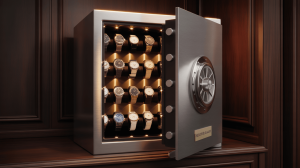Introduction
A jewelry safe with a watch winder blends two functions into one. It stores rings, necklaces, and bracelets. Simultaneously, it keeps automatic watches wound and precise. Many collectors wrestle with separate boxes and winders. This integrated solution saves space. It also reduces the time spent searching for items. You gain convenience, security, and peace of mind. Below, experts weigh in on whether you truly need this hybrid unit.
1. What Is a Jewelry Safe with Watch Winder?
A jewelry safe with a watch winder looks like a cabinet. Padded drawers hold necklaces and rings safely. Built-in rotating modules cradle automatic watches. These modules imitate wrist motion. Secure locks and thick steel walls protect everything inside. Instead of two devices, you get a single, elegant storage solution.
2. Security Benefits
Security matters when storing valuables. These safes typically meet UL RSC burglary standards. Some models carry UL 72 Class 350 fire ratings. This certification means contents stay under 350 °F for at least 30 minutes. Hidden hinges and multi-bolt doors resist prying tools. Biometric or electronic locks add another layer of defense. You can bolt the safe to a wall or floor for extra protection. Overall, you gain vault-grade security for both jewelry and watches.
3. Watch Preservation Advantages
Automatic watches need regular motion to keep lubricants fluid. Without winding, oils can congeal and accuracy drifts. Integrated winding trays offer adjustable turns-per-day (TPD). You can set profiles from 650 to 2,000 TPD. Directional controls (CW, CCW, bi-directional) help match each watch’s requirements. Programmable pauses prevent over-winding. High-quality motors run under 25 dB with rubber-damped mounts to minimize noise. Over time, this care extends service intervals and preserves movement integrity.
| Feature | Specification | Benefit |
|---|---|---|
| TPD Range | 650–2,000 turns/day | Maintains accurate timekeeping |
| Direction Options | CW, CCW, Bi-directional | Protects winding mechanisms |
| Noise Level | < 25 dB | Whisper-quiet operation |
4. Jewelry Organization Features
Jewelry safes offer dedicated compartments for rings and earrings. Ring rolls hold bands upright. Earring posts keep pairs together. Necklace hooks suspend chains to avoid tangles. Velvet or suede linings prevent scratches on precious metals and gemstones. Some safes include hidden drawers for sensitive items or paperwork. This layout ensures that every piece has its own spot. You avoid rummaging through mixed drawers. Everything stays organized and easy to find.
5. Climate Control Importance
Humidity swings can damage pearls, leather straps, and metal settings. Many hybrid safes include desiccant chambers to absorb moisture. Some add active dehumidifiers and IP54-rated seals. Digital hygrometers show real-time humidity levels. Maintaining 40–50 % relative humidity prevents tarnish and strap cracking. Over time, this environment preserves both jewelry and watch movements, reducing restoration or repair costs.
6. Space and Design Considerations
These safes come in various sizes. Some fit on a dresser top, holding two to four watches plus jewelry. Larger floor models handle up to 10 watches and extensive jewelry collections. Designers often match exterior finishes to home décor. Options include matte-black powder-coat, walnut veneer, or leather wrap. Flush-mount keypads and beveled glass add a gallery-like feel. You should measure door swings and drawer clearances before installation. Proper planning ensures seamless integration into your space.
| Model Type | Capacity | Footprint |
|---|---|---|
| Compact Countertop | 2–4 watches, small jewelry | 8×6×6 in |
| Mid-Size Cabinet | 6–8 watches, moderate jewelry | 15×12×10 in |
| Full-Floor Safe | 10+ watches, large jewelry | 20×15×20 in |
7. Smart Technology and Alerts
Integrated Bluetooth or Wi-Fi modules keep you informed. You receive tamper and door-open alerts on your phone. Low-battery and humidity warnings also arrive instantly. A dedicated app lets you adjust TPD settings remotely. You can view audit logs of access events. Enterprise-grade encryption protects these connections. Smart features add convenience and security—anytime, anywhere.
8. Power and Backup Options
Hybrid safes use AC adapters for daily power. They include rechargeable lithium-ion batteries for backup. If power fails, built-in LEDs and app notifications alert you to switch to battery. A hidden mechanical override key or combination dial ensures access even when electronics fail. This multi-layered approach prevents lockouts and maintains winding functions during outages.
9. Installation and Anchoring Best Practices
Professional installation is recommended for heavy models. First, locate floor joists or wall studs with a finder tool. Use heavy-duty lag or sleeve anchors rated for the safe’s loaded weight. Level the safe before tightening bolts to prevent door binding. Conceal anchor heads beneath interior liners or cabinetry trim for a clean look. Proper anchoring ensures both security and stability, especially for units with moving parts.
| Step | Action | Tip |
|---|---|---|
| Locate Studs/Joists | Use a stud finder | Mark points before drilling |
| Choose Anchors | Heavy-duty lag/sleeve anchors | Match anchor strength to weight |
| Level Safe | Adjust base before tightening bolts | Prevent door binding |
10. Noise and Vibration Control
Quality winding motors sit on rubber-damped mounts. Precision bearings keep noise under 25 dB—similar to a whisper. Soft-close hinges and silent locking bolts eliminate clicking and slamming. Even in a quiet bedroom or office, the safe operates unobtrusively. Proper insulation around motor bays prevents vibration from affecting adjacent jewelry compartments or nearby furniture.
11. Maintenance and Care Guidelines
Routine care keeps everything in peak condition. Dust exterior surfaces weekly with a microfiber cloth. Test locks and motors quarterly for smooth operation. Run empty winding cycles monthly to prevent motor stalls. Replace desiccant packs every 6–12 months. Swap backup batteries annually. Lubricate mechanical locks per the manufacturer’s instructions. Keep a service log to track maintenance dates and issues. This schedule prevents humidity spikes and motor wear.
12. Cost and Value Analysis
Hybrid safes range from $1,500 to over $10,000. Entry-level models start at $1,500 for 2–4 winding bays and basic jewelry drawers. Mid-range options ($2,500–$5,000) add climate control, LED lighting, and smart alerts. Premium units ($5,000+) include custom veneers, biometric locks, and full IoT integration. Many insurance companies offer discounts for certified burglary and fire protection. Over time, reduced watch service fees and jewelry repairs can offset upfront costs.
| Tier | Price Range | Key Features |
|---|---|---|
| Entry-Level | $1,500–$2,500 | 2–4 winders, basic jewelry drawers |
| Mid-Range | $2,500–$5,000 | Climate control, LED lighting, app |
| Premium | $5,000+ | Custom finishes, biometric lock |
13. Alternatives and Separate Solutions
If you prefer separate solutions, consider a standalone watch winder and a dedicated jewelry safe.
A basic winder costs $200–$500 for a 2-bay unit.
A jewelry safe runs $300–$800 for moderate capacity.
Separate boxes may save initial cost. But they require more space and effort.
You lose the unified security of a single vault.
Plus, you’ll need multiple passwords or keys.
14. Who Should Invest?
Serious collectors with multiple automatic watches benefit most.
Those with sizable jewelry collections gain organization and security.
If you travel frequently, a hybrid unit offers peace of mind.
Casual wearers might find a basic jewelry safe or winder sufficient.
Evaluate your collection’s value, space constraints, and budget.
Then decide if consolidation outweighs separate devices.
| Collector Profile | Recommended Solution | Rationale |
|---|---|---|
| Watch Enthusiast | Hybrid safe with multiple winder bays | Keeps watches wound and secure |
| Jewelry Aficionado | Hybrid safe with deep drawers | Organizes and protects jewelry |
| Occasional User | Standalone safe / simple winder | Budget-friendly and space-saving |
15. Final Verdict and Recommendations
A jewelry safe with watch winder delivers maximum convenience and security. You eliminate clutter by combining two functions. You gain peace of mind from vault-grade protection and fire resistance. Watches remain accurate without manual winding. Jewelry stays organized and untangled. If your collection includes both automatic watches and valuable jewelry, a hybrid unit is worth the investment. Otherwise, separate solutions might suffice.
FAQ
Q1: Can I store both quartz and automatic watches?
Yes. Quartz watches sit in static trays, while automatics use winding modules.
Q2: How often replace desiccant packs?
Replace every 6–12 months depending on local humidity to maintain ideal RH.
Q3: Are smart alerts secure from hacking?
Premium models use AES encryption and require strong, unique passwords.
Q4: Do these safes require professional installation?
Recommended for heavy or built-in models to ensure proper anchoring and stability.
Q5: Can I expand capacity later?
Yes. Modular trays and drawer kits allow you to add extra winders or jewelry compartments over time.







